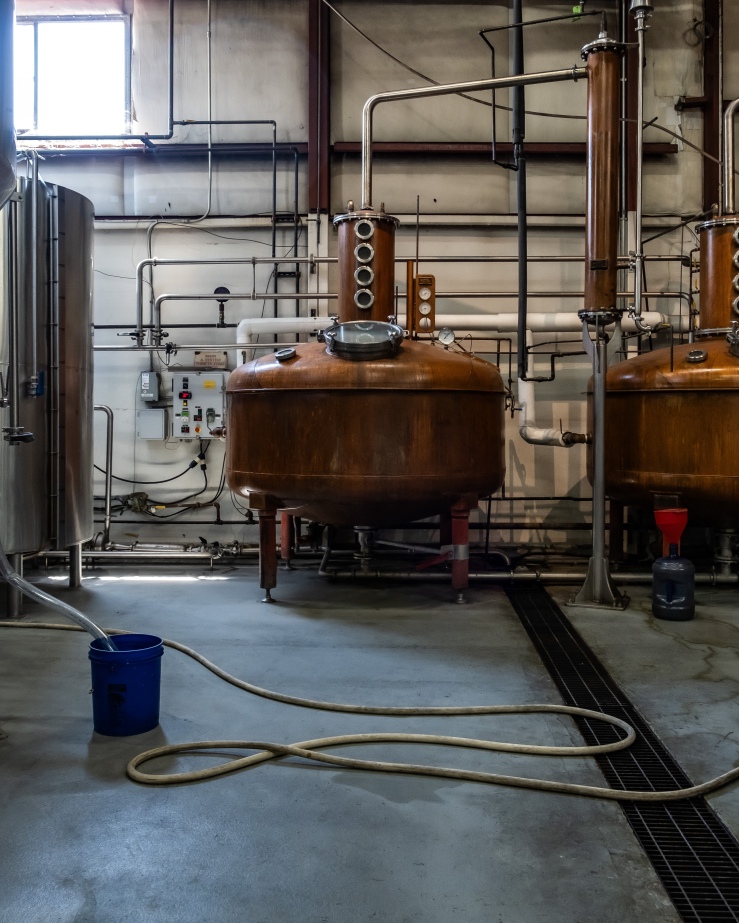Two weeks ago, I zipped from Arizona to Colorado to attend the American Single Malt Whisky Commission Convention in downtown Denver. It was a last-minute trip, but I couldn’t resist the opportunity to one of my favorite cities, try more Colorado whiskies, and see more than 20 American Single Malt distillers all together in one room.
As I stumbled away at the end of the evening, I carried with me a few business cards, several stickers, and five things that excite me about American Single Malt Whiskey right now:
- Peat is just as exciting in American Single Malt Whiskey as it is in Scotch.
- Experimentation is the name of the game in American Single Malt Whiskey.
- There is joy in the American Single Malt Whiskey industry.
- The community of American Whiskey is tight-knit and welcoming.
- Bourbon may be America’s whiskey, but American Single Malts is on the rise.
Keep reading as I expand on each!
Five Things that Excite Me About American Single Malt Whiskey Right Now
As a whisky enthusiast and an American Single Malt Whiskey (ASMW) enthusiast, these five things about the ASMW category that most excite me right now.
The use of peat is just as exciting in American Single Malt Whiskey as it is in Scotch.
I’ll start right out with the most controversial take, fully admitting that not every ASMW drinker (or even every Scotch drinker) will share this opinion. I happen to be a verified Peat Monster. I want peat in my whiskey, and I want it to be so big and bold that it practically crawls out of the glass of its own volition.
American single malt producers are known for experimenting with different types of smoke, and with great success. Whiskey Del Bac, headquartered just a few miles from my home in Tucson, runs on the slogan “mesquited, not peated.” Every month, they light the firebox with locally-sourced wood to complete their in-house malting process. The result is Dorado, a lovely, rich smoky whisky that many local whiskey lovers rave about.
But while “it’s not like peat” was often a selling point for skeptical visitors on the tours I once led at the distillery, the cozy campfire smoke of mesquited barley malt and the brash, medicinal peat of Scotland’s western isles are different. Not better or worse. Just different. And both have their place in ASMW.
For someone who cut their whiskey teeth on peaty Scotch, the use of peat in American whiskies is exciting. I sipped peated whiskey from three distillers at the ASMW Convention: Cedar Ridge Distillery, Boulder Spirits, and McCarthy’s from Hood River Distillers. All three source their peated barley directly from Scotland before mashing and distilling it onsite in the US. And all three were fantastic whiskies that I wouldn’t hesitate to order or buy.

Experimentation is the name of the game in American Single Malt Whiskey.
While my posting here has been sparse over the last few months, there have been commonalities in the distilleries and whiskies I’ve visited and sampled. More often than not, the distilleries are relatively new—especially when compared to the historic distilleries of Kentucky and Ireland and Scotland—and small, some even largely unknown outside of a dedicated local whiskey community.
There is something to be said for this anonymity (or, perhaps in some cases, notoriety). Last summer when I visited Denver on my first whiskey trip, I noted how the city’s various distilleries were forging their own path with local ingredients and innovative practices and philosophies. Even in Edinburgh, I found the same spirit of experimentation when I dropped into Port of Leith and Holyrood distilleries.
Without the 200+ years of distilling history that many big whiskey brands enjoy, making a name for yourself in the whiskey world can certainly be a challenge. But where newer distilleries may falter on history, they’re excelling in innovation.
There is freedom in being unknown, and I see that freedom in the American Single Malt industry in spades. Whiskey Del Bac, as previously mentioned, was one of the first to burn mesquite to dry their malted barley. Iowa’s Cedar Ridge has a delicious whiskey that’s aged in 20+ casks(!!!) before being married in a solera process that keeps various batches all perpetually marinating together. McCarthy Whiskey (officially the first distillery to make American Single Malt) employs brandy stills of just 60 gallons to distill their small-bath whiskey.
If I had to guess, some of this innovation may be born out of necessity. When you’re just getting started in any business, you have to be a little bit scrappy, making do with limited resources. But, as they say, necessity is the mother of all invention.
There is joy in the American Single Malt Whiskey industry.
When I stopped by the Boulder Spirits booth, the team told me that they also make bourbon. They said it almost apologetically, perhaps knowing the crowd that this event would draw. Bourbon, they said, keeps the lights on and the stills running so the team can keep making single malt whiskeys.
This isn’t the first time I’ve heard this tale: bourbon pays the bills, but single malt brings the joy.
Many ASMW distilleries are small, and, according to my sources, have had some real moments of financial struggle in the last year or two. This isn’t Jim Beam or Maker’s Mark, putting out a single malt on a whim. Many of these distilleries are focused on the category simply because they love it.
That passion for single malt was felt through the conversations I had with brand reps (who, admittedly, are paid to smile about their product), but also through the crowd in attendance. ASMW isn’t on every street corner; I’m lucky to live in a town with a distillery producing great barrel-aged spirits, but many aren’t. And the complicated distribution laws and networks of the US mean that the ASMW section in most liquor stores is scant—if they have one at all.
In fact, one of the reasons I went to Denver is because I have tried, and failed, to access whiskey from a wide range of distilleries. I simply can’t get my hands on a bottle. What this means is that the community around single malt whiskeys produced in the US is intentional. People who know about it and love it get excited about it. Some of us even book a last-minute flight for it.

The community of American Whiskey is tight-knit and welcoming.
While visiting Seattle a few years ago, I naturally trekked south of downtown to visit Westland Distillery, still one of my favorite ASMW brands. It was early 2021 and the world was still in the throes of COVID regulations. Officially, the distillery wasn’t offering in-person tours, but when I mentioned that I worked at Del Bac at the time, the doors opened—literally.
With a swift welcome, we were granted special access and taken on a casual walk-through of the production floor and lab. Shortly after, our impromptu tour guide came to Tucson, and I returned the favor by connecting her with the team at Del Bac.
I’ve come to expect this camaraderie in the ASMW community as I’ve visited distilleries and chatted with other fans. ASMW fans and distillers are united in the fact that we’re all rooting for the underdog, both in the US and on a global scale. American Single Malt, while growing, remains the little brother of both American Whiskey and the global single malt industry.
But it’s growing, and the community around it remains part of its appeal. More than once in Denver, I witnessed distillers trading off their duties, allowing each other to venture out into the room and sample their colleagues’ spirits. Almost always, the swap was precipitated with the words, “I really want to try…”
Bourbon may be America’s whiskey, but American Single Malts is on the rise.
Before I left Denver two weeks ago, I got coffee with two members of the Edinburgh Whisky Academy team, Kirsty and Heather. They were in town working alongside the convention on a special project: filming distillers and malters and other experts for their American Single Malt Whiskey Certificate, a new course offering from the EWA.
American Single Malt is, and has been since the first distillation of such, a legitimate category of American whiskey. However, there’s something about a credentialing course that underlines the category’s rightful place in the whiskey world.
Plus, the packed spaces of Seven Grand in Denver proved a significant interest in the category, something dedicated fans of ASMW already knew. It’s my understanding that this year’s event was the inaugural convention. If so, I can’t wait to see it grow and expand over the coming years.

A Challenge to American Scotch Drinkers
Any time someone asks me to compare a single malt whiskey to bourbon, I usually just laugh. I simply don’t have the experience and language of bourbon to make those connections. So while I absolutely advocate for bourbon drinkers to try American Single Malt Whiskey, this section is specifically for Scotch fans living in the United States.
Here’s your challenge: if you haven’t yet, try an American Single Malt Whiskey. And then try another. Buy a bottle, or maybe two. Follow the brands on social media. Sign up for their newsletters. Take a tour.
I’ve linked several brands within this post, but here are a few more worth mentioning. I’ve had the opportunity to sample these whiskies, either in Denver or at my local whiskey bar:
- Deerhammer Distillery
- Hinterhaus Distilling
- Ironton Distillery & Crafthouse
- Judson & Moore Distillery
- Lost Lantern Whiskey (an independent bottler)
- Lost Woods Whiskey Company
- Shelter Distilling
- Stranahan’s Whiskey Distillery
- Virginia Distillery Co.
- Wiggly Bridge Distillery
For even more, check out the American Single Malt Whisky Commission member list, available online.
I won’t tell you to replace your Scotch entirely (I certainly won’t be doing that anytime soon!), but make space in your liquor cabinet for American Single Malt Whiskey, nestling it in next to the Glenmorangies and Macallans and Laphroaigs on your shelf.
Then crack open those bottles and pour yourself a dram.
Sláinte, y’all!

Leave a comment